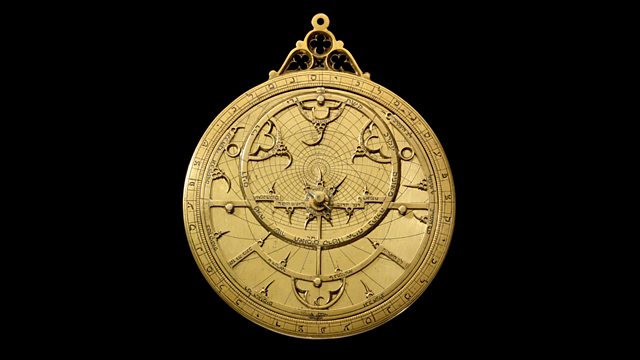Hebrew astrolabe
Neil MacGregor's world history as told through objects. Today he is with an extraordinary medieval astronomical instrument.
Neil MacGregor's world history as told through objects at the British Museum. This week he is exploring high status objects from across the world around 700 years ago. Today he has chosen an astronomical instrument that could perform multiple tasks in the medieval age, from working out the time to preparing horoscopes. It is called an astrolabe and originates from Spain at a time when Christianity, Islam and Judaism coexisted and collaborated with relative ease - indeed this instrument carries symbols recognisable to all three religions. Neil considers who it was made for and how it was used. The astrolabe's curator, Silke Ackermann, describes the device and its markings, while the historian Sir John Elliott discusses the political and religious climate of 14th century Spain. Was it as tolerant as it seems?
Producer: Anthony Denselow
Last on
![]()
Discover more science & technology programmes within A History of the World in 100 Objects
About this object
Location: Spain
Culture: Middle Ages
Period: AD 1345 - 1355
Material: Metal
��
An astrolabe is a scientific instrument used to work out the time of day using the sun or the stars. It could also be used for astrological horoscopes and mathematical calculations. Astrolabes were first made around 150 BC in Greece. They were further developed by Islamic scholars and were often used for determining the exact direction of Mecca. The astrolabe finally came into Western Europe via Spain, which was conquered by Islamic forces in AD 711.
Who was this astrolabe made for?
This astrolabe is inscribed with words in hebrew and Arabic, indicating it was probably made for a Jewish scholar in Spain. Christian forces had reconquered the majority of Spain from the Islamic Caliphate by AD 1238. Spain, however, retained a mixed population of Christians, Jews and Muslims that coexisted in relative harmony. Muslim and Jewish scholars even worked together, translating the works of Aristotle and other Greek authors into Latin. These works had been preserved in Arabic translations but had been largely forgotten in medieval Europe.
Did you know?
- In 1391 poet Geoffrey Chaucer wrote a treatise on the astrolabe for his young son, who was keen to learn how to use one.
Holding the stars
By Silke Ackermann, curator, British Museum
��
��
Everything about this stunning object, including its name, appears unfamiliar at first sight. But for me, just gazing at it is a sheer delight.
When you look at the details on the front, for example, you see this intricate design which looks like a net made of metal. Beautifully carved small pointers have tiny inscriptions next to them – and when one looks closely one realizes that the letters are Hebrew.
But look further and you find shapes that look strangely like the quatrefoil designs of Gothic church windows. And some of those pointers look rather ‘Moorish’ – like designs one might see somewhere in the Middle East. Even the word ‘astrolabe’, which is Greek for ‘star finder’, has a rather exotic ring to it.
But the most exciting bit is that this is not only a stunning object, it is also very practical – one might even say that it was the most sophisticated instrument around before the invention of the computer, just much, much earlier!
The astrolabe has it all: timekeeping, astrology, surveying. Obviously very few people in the past needed to have such knowledge, but those who did wanted the engravings to be really, really precise - so it has always been a rare and expensive piece.
The reasons for having an astrolabe are many. The person responsible at the mosque for calling his fellow Muslims to prayer might have had one. A learned man in ancient Greece might have used it to demonstrate the movements of the stars in the sky. A scholar in medieval Europe might have taught the king trigonometry with it. A Renaissance gentleman may have wanted one to show off his wealth and understanding of the Universe. The wonderful thing is that the astrolabe could cater for all.
Once it had been invented – around 2,000 years ago – it was adapted for different purposes and the designs changed according to when and where it was made, but the basic functions are always the same. So that even an ancient Greek would have had no problem using this small astrolabe we have here.
But perhaps the most fascinating aspect of this small instrument is the fact that it combines Hebrew script with an ‘Islamic’ design and Christian features.
When it was made, in about 1350, probably somewhere in Spain or Southern France, there was a huge amount of exchange of knowledge between Muslim, Jewish and Christian scholars, knowledge that had its roots in ancient Greece. And without that (mostly) peaceful exchange of knowledge we wouldn’t be what we are today. And this small object epitomizes this long story – I just love that.
Transcript
Broadcasts
- Tue 29 Jun 2010 09:45������̳ Radio 4 FM
- Tue 29 Jun 2010 19:45������̳ Radio 4
- Wed 30 Jun 2010 00:30������̳ Radio 4
- Tue 6 Jul 2021 13:45������̳ Radio 4
Featured in...
![]()
Science and Technology—A History of the World in 100 Objects
A History of the World in 100 Objects - objects related to science and technology.
Podcast
-
![]()
A History of the World in 100 Objects
Director of the British Museum, Neil MacGregor, retells humanity's history through objects





